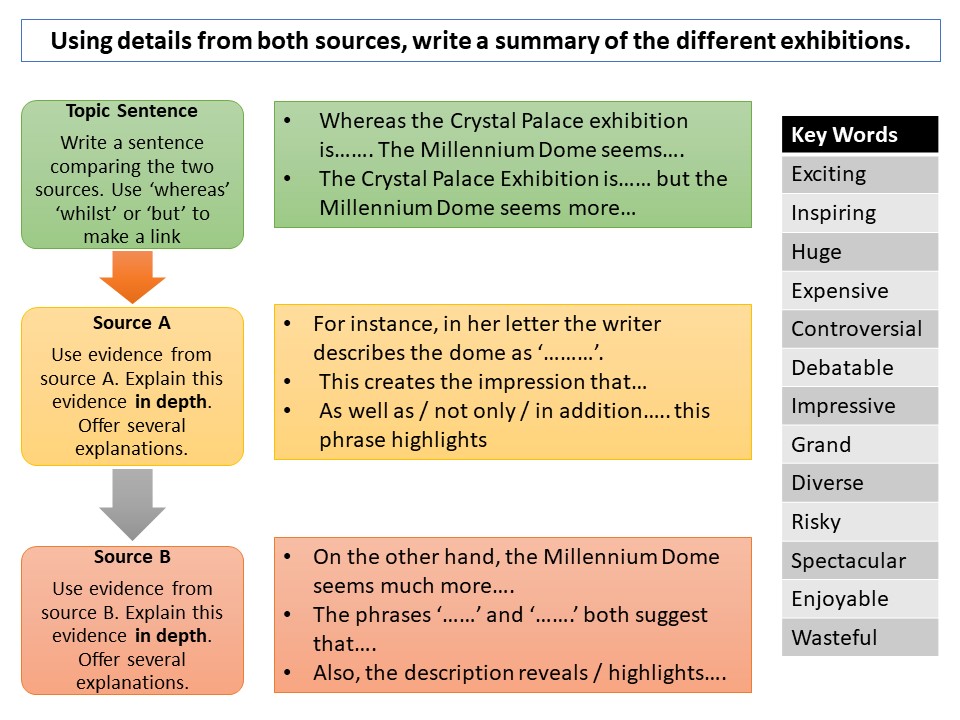This is your third lesson practising the persuasive writing skills you will need for English Language Paper 2. In today’s lesson, we are going to look at a specific writing question and plan a response.
Today you will:
- Recap how to spot the form, audience and purpose of a writing task
- Practise planning an extended piece of writing
- Write an engaging introduction which fits the needs of the audience.
You will need:
- Something to make notes with – either pen/paper or on a computer / device.
TASK ONE:
Read the writing task below. Once you have read it, identify the audience for the task, the purpose of the task and the form or type of writing you are bing asked to attempt. Try to add to your notes ideas about the style, tone and formality you may need to use in your writing
‘Education is not just about which school you go to, or what qualifications you gain; it is also about what you learn from your experiences outside of school.’
Write a speech for your school or college Leavers’ Day to explain what you think makes a good education.
Task One Feedback:
Hopefully you noticed the following things:
- Form: You are being asked to write a speech. This means that you have to imagine your words would be read aloud to an audience, probably sat in front of you!
- Purpose: To explain your ideas on education. This should be an opinionated piece where you seek to persuade your audience.
- Audience: The audience would be students your own age. This might change they way you write, as you would be speaking to your friends and your peers.
TASK TWO: GATHERING IDEAS
Planning: The first stage of planning is to gather ideas. Using either a mindmap or bullet point list, spend 5-10 minutes gathering as many ideas as possible. Use some of the questions below to get you thinking:
- Education: What does this word mean to you? Why is it important? Are there different ways to be educated?
- School: How do schools provide an education? Do they give a wide enough education? Are there things schools do well? Things they do badly?
- Qualifications:Why are things like GCSES and A Levels important? What other things are important that do not appear on tests?
- Experiences: How do other experiences (hobbies, work, home life, friendships) also provide an education? Why are different experiences important?
TIP: At this point it is ok to write down as many ideas as possible. In the next task you will need to choose your best ideas and think about the order they might appear in your speech.
TASK THREE: PLANNING
Now you are going to narrow down your ideas and make a five point plan. I would use five sub-headings and try to follow the planning structure pictured below. Read the blue box for some tips if you get stuck.
You can dowload the planning guidelines here:

TIPS: The most important part of your plan are the middle three paragraphs. Here is where you will make your arguments. If you are stuck, look at the list you made for task two and pick the 3 most interesting and important ideas. 1) What is wrong with education? 2) Why is it so bad? 3) How would you fix it?
TASK FOUR: Writing the opening.
Now you have your plan, let’s get started. Write the opening of your speech. This might only be 4-5 sentences. Remember you are speaking to people your own age at a school assembly / leavers day event.
Tips: Think about how you can engage the audience with some of the techniques you practised in the last two lessons, such as short simple sentences, emotive language or inclusive pronouns (our, we, us).
Possible starting sentences:
Good afternoon everyone. I am extremely pround to be here speaking to you today…
Hello and welcome. First, let me say well done and congratulations for…….
Today, I would like us to consider something incredibly important…
Well, we made it! We have been through…. we have….. we have…… But, can we really say that we have received a true education?
Well done everyone! Don’t forget to upload your work onto SMH and share it with your teacher.


















